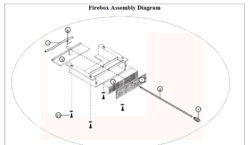re checked the wood I have in the house, pine is 21.5%, maple 17.5%, so the same abouts.
To get as accurate as possible, you need a large split or round, at room temp for a day, then re-split and test on a fresh face, away from the ends. Testing cold wood, or not on a freshly-exposed face, will give a false low reading.
That said, the fact that your cat is at least getting somewhat hot indicates that your wood isn't
super-wet...
QUOTE="John B, post: 2346807, member: 23662"]I find 12 hours burns are pretty easy with this unit. I normally burn with the air only opened like 1/4" from being totally closed and I have also choked down the air intake port on my outside air kit to just a slit. Pipe damper shut as well.
My cat temps tend to cruise between 950-1150 at full bore and I dont usually reload until cat temp is 400-450.[/QUOTE]So you are getting 950-1150 with the air at 1/4" open, right?
The fact that sweedish has to have the air wide open to get similar cat temps is telling me that your wood is drier than his. And as I mentioned, any flame in the box will eat some of the smoke, and he'll get lower cat temp than you do by smoldering the load. He may not be able to smolder damp wood without risking a cat stall, he might need to run a little flame until he gets drier wood to feed it.
a full load of pine, a reload, running wide open, I get a cat probe temp of 1100-1200 degrees, averaging a 2.5 hr burn time, did that twice both with pine. Similar full loads.
Cut the secondary to half, and got a 5 hr burn, cat peak 950. Again with pine, similar sized load as the previous.
I guess you are talking primary air setting...I don't see any separate secondary (cat) air control in the pics.
Reloaded with maple, box stuffed extra fell, as in take a pic and brag about it full, cat probe peaked at 850, secondary air cut to a quarter, then lowest setting. Post results tomorrow.
If your wood is a little damp, the cat probe might go higher a little later in the burn, as the load dries out more and the wood starts gassing better.
You might be tempted to run the stove at higher air settings, in an attempt to get more heat from damp wood, to heat a 3000 sq.ft. space in Michigan.
But be careful that you're not causing "flame impingement" damage to the face of the cat. Look in the box when you have the air on a high setting. Does it look like flame is getting sucked past the flame shield and into the cat?
From your manual:
"Properly operated, the catalytic combustor in your new Kuma Stove will provide years of trouble free use. Over firing of the catalytic combustor is a common cause of failure. Try to avoid direct flame contact with the catalytic combustor. Each chimney will provide a different level of draft. For your first few fires, watch the flames as the lick up near the baffle assembly. If your chimney provides enough draft to pull the flames into the combustor, lower the amount of air by pushing the air control in towards the stove. If flames are still pulled into the combustor, a damper may be installed in the pipe to help further regulate draft."
It looks like the flame shield may be very close to the cat, judging from this diagram, so flame impingement could be an issue.
I'm also curious about how part #7 works, "baffle bypass gasket." The Buck was constructed a bit differently, and didn't have a gasket there...


On the Buck, flame wasn't hitting the cat but cat temp could still go too high with too much air, pushing 1800.

Temps of 1500 or less will prolong the life of the cat. But I haven't seen any reports from Sequoia owners about high cat temps...
I'm going to go out on a limb here and guess that you need to install a damper. When I talked with Kuma about my free standing Sequoia they made sure to tell me to get a damper since my chimney is 25ft straight shot up.
The reason to install a pipe damper to control draft, as they suggest, is that it works better than the band-aid solution of blocking off the air entering the stove with tape. The box of the stove is still subjected to high draft, and will pull additional air past gaskets and other areas in the box. Only with a damper past the box will you get closer to the draft they designed the stove to work with. Some guys even put it two dampers on tall chimneys but sweed doesn't have room to do that with an insert...he might try blocking the holes in the stock damper plate, to provide more control with a single damper.


 Mine was...uh, I forget, Tamarack, Hemlock...some kind of soft wood.
Mine was...uh, I forget, Tamarack, Hemlock...some kind of soft wood. For one thing, can you post pics of the door latch assembly?
For one thing, can you post pics of the door latch assembly?

 Temps of 1500 or less will prolong the life of the cat. But I haven't seen any reports from Sequoia owners about high cat temps...
Temps of 1500 or less will prolong the life of the cat. But I haven't seen any reports from Sequoia owners about high cat temps...